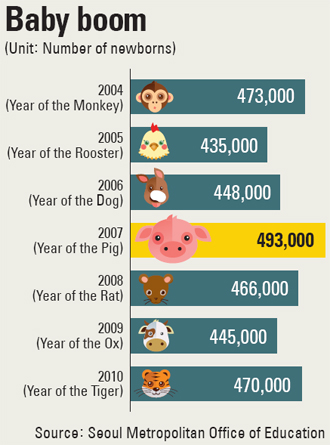Elementary schools see more pupils, less space

The number of new freshmen is expected to surge this year, and that’s where her concern lies: The influx means there won’t be enough classroom space to accommodate all of them.
“This year, we will see a 20 percent increase in the number [of children],” Jang said.
“That means the number of first-year students will increase to 380 from 318 now,” she said, adding that the student-teacher ratio will jump to about 26:1 from Seoul’s primary school average of 19:7.
In 2007 - the year these first graders were born - the birth rate swelled to more than 45,000 additional babies from the previous year. It was the Year of the Pig in the Chinese zodiac, and many Asians believe those born under that sign will be blessed with fortune and prosperity.
But now, these lucky babies need spots in primary schools, which has placed intense pressure on institutions nationwide, particularly those in urban areas.
But Jang is not alone in her concerns.
Cho Yong-cheol, the principal of Banwon Elementary School, is dealing with a similar problem.
“We currently have eight classes in the first grade to accommodate 263 freshman pupils,” Cho said. “But that number will increase to 330, which means we need to accept an additional 63 children, but we can only establish one new class.”
Some parents have expressed concerns that increased class sizes will result in fiercer competition.
“I think my child will have more competition when it comes to securing a seat in a good university or finding a decent job,” said one 35-year-old mother who has a 7-year-old son. “So I tried to take extra care for his education.”
The woman’s son was born in 2007, but she managed to put him in primary school a year earlier because of concerns over the rapid increase in the number of students.
Experts say that many parents are now paying closer attention to when they give birth, and more couples are opting to have only one or two children.
“There is a tendency among parents to try to have children in years associated with good fortunes or years in which big events, like the World Cup, are hosted,” said Ryoo Seok-choon, a sociology professor at Yonsei University. “So schools and the government need to prepare for the projected surge or the decrease in demographics.”
BY KIM SEONG-TAK [ejpark@joongang.co.kr]










with the Korea JoongAng Daily
To write comments, please log in to one of the accounts.
Standards Board Policy (0/250자)